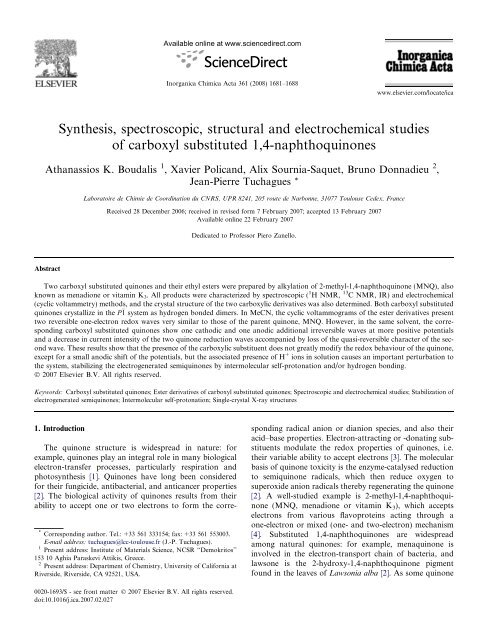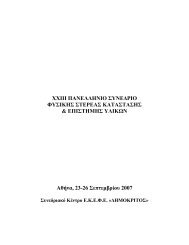Synthesis, spectroscopic, structural and electrochemical studies of ...
Synthesis, spectroscopic, structural and electrochemical studies of ...
Synthesis, spectroscopic, structural and electrochemical studies of ...
Create successful ePaper yourself
Turn your PDF publications into a flip-book with our unique Google optimized e-Paper software.
1686 A.K. Boudalis et al. / Inorganica Chimica Acta 361 (2008) 1681–1688superimposed in Fig. 2. In good agreement with thosefound by Peover [24], the redox potentials (E 1/2 ) for theparent quinone, MNQ to MNQ (reversible) <strong>and</strong> MNQ to MNQ 2 (quasi-reversible) are 0.71 <strong>and</strong> 1.16 V versusSCE, respectively. The redox behaviour <strong>of</strong> the 3-carboxylsubstituted derivatives, 3 <strong>and</strong> 4, is very different. The intensity<strong>of</strong> the two quinone reduction waves has decreased, thequasi-reversible character <strong>of</strong> the second wave has almostdisappeared, <strong>and</strong> the potentials for both reductions aremore negative. In addition, two irreversible pre-peaks,E pc = 0.75 <strong>and</strong> 0.81 <strong>and</strong> E pa = 0.08 <strong>and</strong> 0.03 V for 3<strong>and</strong> 4, respectively, are present. As previously reported[25,26], the shift <strong>of</strong> the quinone reduction toward negativepotentials with regard to MNQ (Table 4) most probablyoriginates from the presence <strong>of</strong> an electron-donating 3-substituentin compounds 3 <strong>and</strong> 4. We notice that the length <strong>of</strong>the aliphatic chain bearing the carboxylic group has no significantinfluence on the first redox potential measuredE 1=2 ¼ 0:87 (3) <strong>and</strong> 0.86 V versus SCE (4).The occurrence <strong>of</strong> a prepeak upon addition <strong>of</strong> acids toquinones [22,25–28] <strong>and</strong> also in the case <strong>of</strong> quinones includinga substituent able to act as a proton source or to promotehydrogen bonding [29] has been reported. Itspresence associated with changes in the usual reductionwaves <strong>of</strong> quinones has been rationalized on the basis <strong>of</strong>an ECE (e H + e ) mechanism involving protonation <strong>of</strong>the semiquinone radical prior to the second electron transfer<strong>and</strong>/or stabilization <strong>of</strong> the electro-generated intermediatespecies by hydrogen bonding [22,25–28]. Since thesubstituent <strong>of</strong> quinones 3 <strong>and</strong> 4 bears an acidic proton, theirpeculiar reduction voltammogram may be explained byintramolecular self-protonation <strong>and</strong> hydrogen bonding:the proton source is the substituent <strong>of</strong> the quinone, <strong>and</strong>its hydrogen bonding to the electro-generated base stabilizesthe latter through formation <strong>of</strong> hetero-conjugateFig. 2. Cyclic voltammograms (scan rate 0.1 V s 1 ) obtained for compoundsMNQ (dashed line), 4 (black line) <strong>and</strong> 6 (dashed <strong>and</strong> dotted line)in acetonitrile. The concentration was 10 2 M in all cases (experimentalconditions as described in Table 4).acid–base dimers [29,30]. Indeed, consecutive scans includingthe 0 ! 0.65 ! 1 ! 0.85 ! 1 ! 1.5 ! 1Vranges show that the pre-peaks <strong>of</strong> 3 <strong>and</strong> 4 are associatedwith the Q to SQ reduction as illustrated in FigureSM.1. In the transient state, the slope <strong>of</strong> i/ p v versus log(v)is 0 (0.75–50 V s 1 range, Figure SM.2), indicating that (i)the first <strong>electrochemical</strong> process ( 0.75 (3), 0.81 V versusSCE (4)) is unique <strong>and</strong> independent <strong>of</strong> the sweeping rate,<strong>and</strong> (ii) taking into account the current measured at the electrode,the process involves most probably one e . On theother h<strong>and</strong>, in the steady state, while the intensity <strong>of</strong> the first<strong>electrochemical</strong> process ( 0.75 (3), 0.81 V versus SCE (4))remains constant, the current <strong>of</strong> the second <strong>electrochemical</strong>process ( 0.92 (3), 0.91 V versus SCE (4)) increases significantlywith the sweeping rate (Figure SM.3), indicatingpassivation <strong>of</strong> the electrode: examination <strong>of</strong> the active electrodesurface with a microscope shows a deposit confirmingthis interpretation. It is likely that the species (probably aradical) formed upon the first reduction process in the0.75 to 0.81 V range converts into a dimer that deposits<strong>and</strong> passivates the electrode. In addition, because organicacids with medium strength act as proton sources uponboth Q–SQ <strong>and</strong> SQ to Q 2 electron transfers [26], bothreduction waves <strong>of</strong> 3 <strong>and</strong> 4 are negatively shifted. Thepotential <strong>of</strong> the pre-peak in the presence <strong>of</strong> H + (originatingfrom the carboxyl substituent) can be written asE 00new ¼ E00 2 þ E00 12þ 2:3RT ðpKQ a2FpK a Þwith pK Q acorresponding to the pK a <strong>of</strong> the quinonoid part<strong>and</strong> pK a to the acid substituent [28].The cyclic voltammograms <strong>of</strong> MNQH 2 <strong>and</strong> <strong>of</strong> MNQ inthe presence <strong>of</strong> an external proton source (0.5 M H + ,ðBF 4Þ, recorded as control experiments, confirm that apre-peak different from the oxidation <strong>of</strong> MNQH 2 , butrelated to the presence <strong>of</strong> H + , appears (Figure SM.4).The potential difference between the pre-peak <strong>and</strong> the firstquinone reduction is <strong>of</strong> the same order <strong>of</strong> magnitude in thecase <strong>of</strong> MNQ (0.19 V) <strong>and</strong> 3 (0.17 V), supporting ourassumption that the pre-peak in 3 is also related to thepresence <strong>of</strong> H + .With the goal to check the involvement <strong>of</strong> the carboxylsubstituent <strong>of</strong> 3 <strong>and</strong> 4 in the redox behaviour <strong>of</strong> these quinonederivatives, esterification <strong>of</strong> the carboxyl substituents<strong>of</strong> 3 <strong>and</strong> 4 was carried out, yielding the 3-ester substitutedderivatives, 5 <strong>and</strong> 6, respectively. The cyclic voltammograms<strong>of</strong> 5 <strong>and</strong> 6 were measured in aprotic <strong>and</strong> water-free(acetonitrile) media identical to that for MNQ <strong>and</strong> the carboxylsubstituted derivatives, 3 <strong>and</strong> 4. As shown in Fig. 2<strong>and</strong> Table 4, two one-electron redox waves, attributed tothe formation <strong>of</strong> Q (reversible) <strong>and</strong> Q 2 (quasi-reversible),respectively, clearly indicate that the redox behaviour<strong>of</strong> 5 <strong>and</strong> 6 is similar to that observed for the parent quinoneMNQ. The only difference is a shift in the redox potentialstoward more negative values with regard to MNQ (Table4) which, as previously reported [25,26], most probablyð3Þ
A.K. Boudalis et al. / Inorganica Chimica Acta 361 (2008) 1681–1688 1687originates from the presence <strong>of</strong> an electron-donating 3-substituentin compounds 5 <strong>and</strong> 6.5. ConclusionsThe aim <strong>of</strong> this study was to further extend our investigationson iron-quinone complexes [6], <strong>and</strong> more specificallyto prepare new lig<strong>and</strong>s allowing us to locate analkylated 1,4-naphthoquinone moiety in the second coordinationsphere <strong>of</strong> iron(II) through binding <strong>of</strong> a carboxylsubstituent [31] borne by its alkyl chain. To this purpose,we have prepared, <strong>spectroscopic</strong>ally (IR,1 H <strong>and</strong>13 C NMR) <strong>and</strong> <strong>structural</strong>ly characterized, <strong>and</strong> extensivelystudied the <strong>electrochemical</strong> properties <strong>of</strong> two quinonederivatives <strong>of</strong> organic acids, 3-3 0 -methyl-1 0 ,4 0 -dioxo-1 0 ,4 0 -dihydronaphthalen-2 0 -yl propanoic acid (3) <strong>and</strong> 4-3 0 -methyl-1 0 ,4 0 -dioxo-1 0 ,4 0 -dihydronaphthalen-2 0 -yl butanoicacid (4), derived from MNQ. An improved purificationmethod allowed us to obtain pure 3 <strong>and</strong> 4 in high yield,<strong>and</strong> subsequently to grow single crystals allowing to determinetheir molecular structure. The exhaustive <strong>electrochemical</strong>study <strong>of</strong> 3 <strong>and</strong> 4 led us to prepare <strong>and</strong> fullycharacterize their ethyl esters, 5 <strong>and</strong> 6, respectively. This<strong>electrochemical</strong> study has evidenced that the redox behaviour<strong>of</strong> the 3-carboxyl substituted derivatives 3 <strong>and</strong> 4 isvery different from that <strong>of</strong> MNQ, while their esters 5 <strong>and</strong>6 have the typical redox behaviour <strong>of</strong> 1,4-naphthoquinoneslike MNQ. The origin <strong>of</strong> this difference has been elucidated:the presence <strong>of</strong> a substituent able to act as a protonsource, <strong>and</strong> to promote hydrogen bonding, associated withchanges in the usual reduction waves <strong>of</strong> quinones has beenrationalized on the basis <strong>of</strong> an ECE (e H + e ) mechanisminvolving intramolecular self-protonation <strong>of</strong> the semiquinoneradical prior to the second electron transfer <strong>and</strong> stabilization<strong>of</strong> the electro-generated intermediate species,probably an hetero-conjugate acid–base dimer, by hydrogenbonding [22,25–30]. It is then expected that coordination<strong>of</strong> the (deprotonated) carboxo substituent <strong>of</strong> 3 <strong>and</strong> 4to a metal centre may yield an alkylated 1,4-naphthoquinonemoiety in the second coordination sphere <strong>of</strong> iron(II)showing the typical redox behaviour <strong>of</strong> 1,4-naphthoquinones:the preparation <strong>and</strong> study <strong>of</strong> such metal complexesis presently underway in our laboratories.AcknowledgementsA.K.B. thanks the European Community for partialsupport through a doctoral grant within the framework<strong>of</strong> the TMR contract FMRX-CT980174. We thank Dr.Yannick Coppel, Dr. Penelope Liatsi <strong>and</strong> Dr. MontserratRodriguez for helpful discussions.Appendix A. Supplementary materialCCDC 258106 <strong>and</strong> 258107 contain the supplementarycrystallographic data for 3 <strong>and</strong> 4. These data can beobtained free <strong>of</strong> charge via http://www.ccdc.cam.ac.uk/conts/retrieving.html, or from the Cambridge CrystallographicData Centre, 12 Union Road, Cambridge CB21EZ, UK; fax: (+44) 1223-336-033; or e-mail: deposit@ccdc.cam.ac.uk. Supplementary data associated with thisarticle can be found, in the online version, atdoi:10.1016/j.ica.2007.02.027.References[1] (a) R.H. Thomson, Naturally Occurring Quinones, Academic Press,New York, 1971;(b) R.A. Morton, Biochemistry <strong>of</strong> Quinones, Academic Press, NewYork, 1965.[2] P.J. O’Brien, Chem. Biol. Interact. 80 (1991) 1.[3] (a) P. Zuman, Substituent Effects in Organic Polarography, PlenumPress, New York, 1967;(b) S. Patai, The Chemistry <strong>of</strong> the Quinonoid Compounds, Wiley,London, 1974.[4] (a) T. Iyanagi, I. Yamazaki, Biochim. Biophys. Acta 216 (1970) 282;(b) M. Nakamura, I. Yamazaki, Biochim. Biophys. Acta 267 (1972)249.[5] R.M. Buchanan, C.G. Pierpont, Coord. Chem. Rev. 38 (1981) 45.[6] (a) P. Garge, S. Padhye, J.-P. Tuchagues, Inorg. Chim. Acta 157(1989) 239;(b) P. Garge, R. Chikate, S. Padhye, J.-M. Savariault, P. de Loth, J.-P. Tuchagues, Inorg. Chem. 29 (1990) 3315.[7] (a) J. Deisenh<strong>of</strong>er, O. Epp, K. Miki, R. Huber, H. Michel, J. Mol.Biol. 180 (1984) 385;(b) J. Deisenh<strong>of</strong>er, O. Epp, K. Miki, R. Huber, H. Michel, Nature318 (1985) 19;(c) H. Michel, O. Epp, J. Deisenh<strong>of</strong>er, EMBO J. 5 (1986) 2445;(d) J. Deisenh<strong>of</strong>er, H. Michel, Angew. Chem., Int. Ed. 28 (1989) 829;(e) J.P. Allen, G. Feher, T.O. Yeates, H. Komiya, D.C. Rees, Proc.Natl. Acad. Sci. USA 84 (1987) 5730;(f) J.P. Allen, G. Feher, T.O. Yeates, H. Komiya, D.C. Rees, Proc.Natl. Acad. Sci. USA 85 (1988) 8487.[8] (a) A. Zouni, H.-T. Witt, J. Kern, P. Fromme, N. Krauß, W.Saenger, P. Orth, Nature 409 (2001) 739;(b) K.N. Ferreira, T.M. Iverson, K. Maghlaoui, J. Barber, S. Iwata,Science 303 (2004) 1831.[9] (a) R.K. Clayton, Photosynthesis: Physical Mechanisms <strong>and</strong> ChemicalPatterns, Cambridge University Press, 1980;(b) B.A. Diner, G.T. Babcock, in: D.R. Ort, C.F. Yocum (Eds.),Oxygenic Photosynthesis: The Light Reactions, Kluwer AcademicPublishers, Dordrecht, 1996, pp. 213–247.[10] P. Cassoux, R. Dartiguepeyron, D. de Montauzon, J.B. Tommasino,P.L. Fabre, Actual. Chim. 1 (1994) 49.[11] L. Heslinga, W. Schwaiger, Recl. Trav. Chim. 85 (1966) 75.[12] L.F. Fieser, R.B. Turner, J. Am. Chem. Soc. 69 (1947) 2338.[13] SIR92 – A program for crystal structure solution A. Altomare, G.Cascarano, C. Giacovazzo, A. Guagliardi, J. Appl. Crystallogr. 26(1993) 343.[14] SIR97– A. Altomare, M.C. Burla, M. Camalli, G.L. Cascarano, C.Giacovazzo, A. Guagliardi, A.G.G. Moliterni, G. Polidori, R.Spagna, J. Appl. Crystallogr. 32 (1999) 115.[15] G.M. Sheldrick, SHELX97 [Includes SHELXS97, SHELXL97, CIFTAB] –Programs for Crystal Structure Analysis (Release 97-2), Institüt fürAnorganische Chemie der Universität Göttingen, Göttingen, Germany,1998.[16] WINGX – 1.63 integrated system <strong>of</strong> windows programs for the solution,refinement <strong>and</strong> analysis <strong>of</strong> single crystal X-ray diffraction data L.Farrugia, J. Appl. Crystallogr. 32 (1999) 837.[17] International Tables for X-Ray Crystallography, vol. IV 1974,Kynoch Press, Birmingham, Engl<strong>and</strong>.[18] ORTEP3 for Windows – L.J. Farrugia, J. Appl. Crystallogr. 30 (1997)565.
1688 A.K. Boudalis et al. / Inorganica Chimica Acta 361 (2008) 1681–1688[19] L.F. Fieser, A.E. Oxford, J. Am. Chem. Soc. 64 (1942) 2060.[20] L. Salmon-Chemin, E. Buisine, V. Yardley, S. Kohler, M.-A. Debreu,V. L<strong>and</strong>ry, C. Sergheraert, S.L. Cr<strong>of</strong>t, R.L. Krauth-Siegel, E.Davioud-Charvet, J. Med. Chem. 44 (2001) 548.[21] (a) D.H.R. Barton, W. Sas, Tetrahedron 46 (1990) 3419;(b) P.K. Malinen, A.Y. Tauber, J. Helaja, P.H. Hynninen, LiebigsAnn. 8 (1997) 1801.[22] N. Gupta, H. Linschitz, J. Am. Chem. Soc. 119 (1997) 6384.[23] M.W. Lehmann, D.H. Evans, J. Electroanal. Chem. 500 (2001) 12.[24] M.E. Peover, J. Chem. Soc. (1962) 4540.[25] K. Sasaki, T. Kashimura, M. Ohura, Y. Ohsaki, N. Ohta, J.Electrochem. Soc. 137 (1990) 2437.[26] J. Kim, T.D. Chung, H. Kim, J. Electroanal. Chem. 499 (2001) 78.[27] (a) K. Takamura, Y. Hayakawa, J. Electroanal. Chem. 31 (1971) 225;(b) K. Takamura, T. Fuse, K. Arai, F. Kusu, J. Electroanal. Chem.468 (1999) 53.[28] H.-S. Kim, T.D. Chung, H. Kim, J. Electroanal. Chem. 498 (2001)209.[29] P.A.L. Ferraz, F.C. de Abreu, A.V. Pinto, V. Glezer, J. Tonholo,M.O.F. Goulard, J. Electroanal. Chem. 507 (2001) 275.[30] M. Yamanuki, T. Hoshino, M. Oyama, S. Okazaki, J. Electroanal.Chem. 458 (1998) 191.[31] G. Lemercier, E. Mulliez, C. Brouca-Cabarrecq, F. Dahan, J.-P.Tuchagues, Inorg. Chem. 43 (2004) 2105.
















